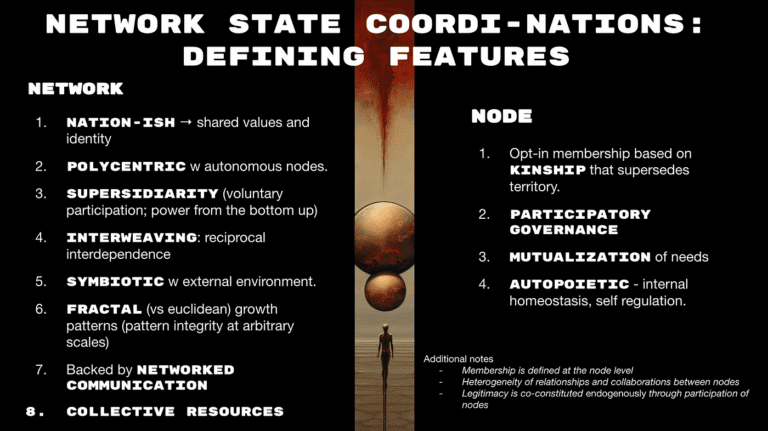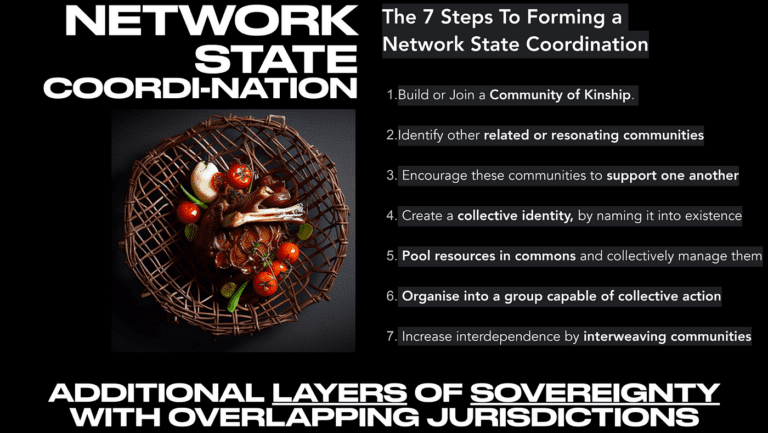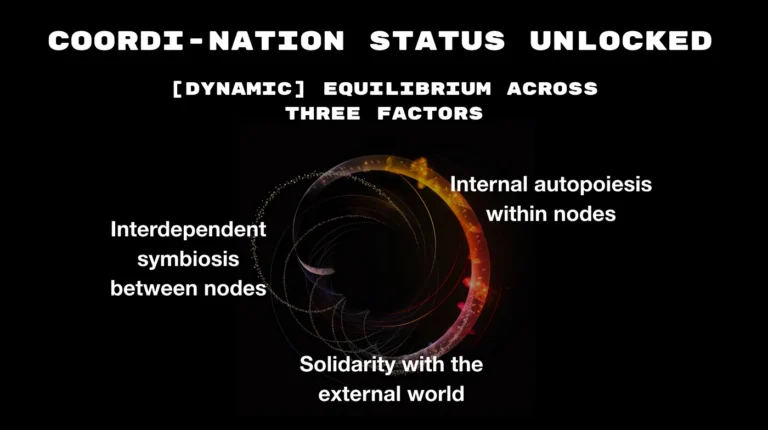Coordi-nation: A New Institutional Structure for Global Cooperation

Primavera de Filippi and Jessy Kate Schingler, June 13, 2023.
Introduction
Networked communications have enabled new ways for people to coordinate and to engage in collective action, achieving shared goals and upholding shared values. Meanwhile, existing governance institutions — including governments and nation states — are failing to keep up with the changes brought about by these networked technologies. In this essay, we elaborate upon the notion of “coordi-nations” as a new type of organizational structure that can foster cooperation at a (local and) global scale, through shared values and participatory decision-making. Coordi-nations are a new form of network sovereignty that spans traditional geographical boundaries. By harnessing the power of digital communities and modern information technologies, coordi-nations provide innovative solutions to complex global coordination challenges, by promoting cooperation and acknowledging interdependencies amongst transnational communities.
The Limitations of States
“Nation-states fail when they are consumed by internal violence and cease delivering positive political goods to their inhabitants. Their governments lose credibility, and the continuing nature of the particular nation- state itself becomes questionable and illegitimate in the hearts and minds of its citizens. The rise and fall of nation-states is not new, but in a modern era when national states constitute the building blocks of world order, the violent disintegration and palpable weakness of selected African, Asian, Oceanic, and Latin American states threaten the very foundation of that system.” — Rotberg R (2003), ‘The Failure and Collapse of Nation-States: Breakdown, Prevention, and Repair’, in ‘When States Fail: Causes and Consequences’
Nation-states, despite their historical significance, are politically hegemonic structures that are failing to keep up with the changes brought on by networked communication and globalization. Membership in traditional nation-states is determined by blood or by land, without easy mechanisms to opt-in or opt-out. Citizenship within the framework of the state often requires choosing a single one, such that pluralistic allegiances and protections are rarely possible. States struggle to address global challenges (such as climate change) or challenges where cooperation is needed beyond national borders. Territorially-bound governance and sovereignty have contributed to institutional inertia, especially in the international arena, leading to a significant erosion of trust in many state institutions, and a decreasing sense of agency and shared identity among individual citizens.
The Emergence of Coordinations
Coordi-nations are a new institutional structure that offers an innovative and collaborative approach to global cooperation and coordination. They tap into the potential of information and communication technologies, providing opportunities for global governance and collective agency that were previously unexplored. Coordi-nations do not seek to replace the institution of the “state” but rather offer a new take on the existing concept of the “nation” that supports and cultivates emergent networked identities (i.e. digital nations). Coordi-nations rely on modern information and communication technologies to create new infrastructures of sovereignty, which allows for the progressive evolution and independent spheres of operation over time.
Coordi-nations versus Traditional Nations
Although coordi-nations are organized around features such as kinship, shared identity, and belonging that have nation-like qualities, they also differ from the traditional concept of national identity in several ways.
Nations are often territorially bound, and membership is generally determined by birthright (although mechanisms for opt-in citizenship also exist). Coordi-nations are non-territorial in nature; they form through voluntary association, shared values, and mutualism, rather than geographic boundaries or inherited identity. People voluntarily join or associate with one or more coordi-nations based on their affinity with that coordination’s activities and values.
As opposed to traditional nations — many of which govern themselves through the centralized institutions of the state — coordi-nations prioritize participatory governance and decentralized decision-making in a self contained domain that exists in parallel to the state.
Traditional national identity is perceived as a singular, overarching organizing principle of a person’s identity, whereas coordi-nations recognize and embrace plurality. Individuals can identify with multiple coordi-nations, allowing for the coexistence of multiple identities.
Coordi-nations vs Balaji’s Network State
Coordi-nations share some similarities with Balaji Srinivasan’s concept of the Network State. They both relate to alternative forms of governance and coordination beyond the Westphalian state system, and both are forms of network sovereignties that respond to the new capacities enabled by modern information and communications technologies. However, they also differ in their underlying principles and approaches in certain important ways:
- Scope: Balaji’s conceptualisation of the network state envisions a comprehensive replacement or alternative to traditional nation-states. It seeks to create a parallel state infrastructure that operates through digital networks and platforms. Coordi-nations, on the other hand, do not necessarily aim to replace nation-states but rather explore new ways in which existing and emerging network sovereignties can be supported or formed via digital technologies. Coordi-nations introduce new layers of sovereignty that are not inherently territorial.
- Approach to Identity: Balaji’s network state concept does not specifically address the formation of collective identities or national identities, but rather focuses on the use of technology to coordinate groups of aligned individuals. Coordi-nations, on the other hand, emphasize the endogenous formation of collective identities and belonging as a defining criteria, based on shared values, solidarity, mutualization, agentic governance and voluntary association.
- Technological Emphasis: Balaji Srinivasan’s network state concept heavily relies on technology, particularly blockchain and digital platforms, to enable new forms of governance and coordination. It envisions the use of digital currencies, smart contracts, and decentralized applications as core infrastructure of the network state. Coordi-nations may rely on blockchain technology to the extent that it is instrumental to facilitate the governance of new networked identities, in a way that is more compatible with the principles of self-sovereignty and self-determination.
- Relationship to Existing Institutions: With his definition of the network state, Balaji does not propose a significant departure from the institutional form of the state. Coordi-nations, on the other hand, do not seek to replicate the existing institutional form of the state, but rather aim to support and cultivate new layers of sovereignty associated with networks. Coordi-nations cultivate opportunities for mutualism and solidarity outside the framework of existing institutions, without necessarily competing with them. Yet, insofar as both network states and coordi-nations can acquire diplomatic recognition by other states, both could potentially enter into partnership with other nation states and other relevant actors in international relations.
Defining Features of Coordi-nations

Coordi-nations are an emergent form of networked sovereignty. They rely on networked communities as an animating force for cooperation, collaboration, mutualism and solidarity in a context of growing global interdependencies. The growth of networked communities may have significant implications for global governance, global trade and mobility.
While every coord-nation will be different, there are certain defining features that they all share in common. Coordi-nations are designed around voluntary association and participatory governance. The nodes of a coordi-nation have achieved a certain level of self-regulation (autopoiesis) in the provision of internal needs (mutualization), before entering into relationships with other nodes. This ensures that nodes enter into relationships with other nodes in the coordi-nation based on their own agency and effective governance.
The network aspect of the coordi-nation emerges from a bottom-up process of “supersidiarity” where nodes willingly decide to mutualize resources at the network level, as a means to facilitate and embrace a reciprocal interdependence. As a result of this process, the sense of identity and belonging grows to include the network level as well as the node. Individual nodes are not subsumed by the network; rather they become the constitutive parts of the network.
Through this collectivization and mutualisation of resources, coordi-nations reduce incentives for free-riding, creating “economies of scope” where all nodes are better off than they would be otherwise, and the successes or advancements of any one node will have positive repercussions on the coordi-nation as a whole.
Coordi-nations do not leverage economies of scale for their own growth, but rather expand through a process of fractal replication and interconnection between nodes that share similar cultural and functional patterns. This creates an implicit literacy between nodes that reduces the overhead for interaction, collaboration and cross-pollination, creating a recognizable “pattern integrity” across the network as a whole.
Finally, coordi-nations are autopoietic systems that are operationally closed but cognitively open to interface with the external environment. They create symbiotic relationships with the outside world, seeking new ways to exchange resources, people and ideas with external systems. This produces learning loops thereby allowing for the coordi-nation to constantly adapt and innovate.
The recipe for creating a coordi-nation has 7 steps

- Build or Join a Community of Kinship: find or found a community that purports to fulfill the needs of its members through participatory governance and voluntary participation.
- Identify other related or resonating communities: find communities that share the same “pattern integrity.”
- Encourage these communities to support one another: explore bilateral or multilateral collaborations across communities that are mutually beneficial.
- Create a collective identity, by naming it into existence: the act of naming creates a referent that catalyzes the process of identity formation, both from within and from outside the collective.
- Pool resources in common and collectively manage them: delegate and redistribute resources endogenously within the network through a process of super-sidiarity. This requires establishing a governance structure for the management of the resources held in common.
- Organize into a group capable of collective action: leverage capacities and common resources to operate exogenously. The collective becomes an agent acting on its own behalf, with its own resources and identity.
- Increase interdependence by interweaving communities: nodes in the network share forms of equity with one another, thereby increasing the costs of exit and ensuring the long-term sustainability of a collective that is greater than the sum of its part. Allow for processes of mutual adjustment that allow for stable formations to emerge at the network level.

Coordi-nations and Institutional Scaffolding
Coordi-nations rely on new forms of institutional scaffolding in order to support the governance of new types of ‘networked’ nations. These institutional structures may look very different from the familiar infrastructure of the state. By emphasizing bottom-up supersidiarity, adaptability, and interconnectedness, coordi-nations allow for the creation of new layers of sovereignties that operate independently of existing nation states , yet nonetheless maintain an interface and symbiotic relationship with the existing state system.
Exclosures are institutional rules the sole purpose of which are to protect particular community dynamics from the institutional environment around it. An exclosure leverages the rules of a particular system in order to build a protective membrane that prevents the institution from trespassing into this newly carved out territory. The power of an exclosure is that it speaks the same language (or ruleset) as the institutional enclosures that it tries to escape from, creating a “fence within a fence”. Thus, the only way for the surrounding system to reach inside the exclosure would be for it to break its own rules.
Exclosures can be a useful way for coordi-nations to coexist with existing nation states by carving out space for experimenting with new power structures and governance models based on autonomy and self-determination, while still maintaining connections and engaging in constructive relationships with existing nation states. Specifically, exclosures can be instrumental to coordi-nations in the following ways:
- Testing and Prototyping: Coordi-nations require the flexibility to test and prototype different forms of governance and organization. Exclosures allow them to create and operate in specific domains independent of territorial laws and regulations, creating an environment conducive to experimentation. These innovations can potentially influence and inspire broader societal and governmental systems, contributing to the evolution of governance structures at all levels.
- Autonomy and Self-Determination: Exclosures enable coordi-nations to establish their own set of rules and norms, allowing for members to collectively shape their desired system of governance. Autonomy ensures that the coordi-nation can align its practices and decision-making processes with the values and interests of its members without undue interference from external authorities.
- Flexibility and Adaptability: Exclosures provide coordi-nations with the flexibility to respond to changing circumstances and evolving needs. Coordinations remain agile and responsive, fostering their capacity to cooperate with other stakeholders, including nation-states, while maintaining their distinct identities and goals.
Conclusion
In conclusion, coordi-nations represent a new institutional structure that can act at the geopolitical level, and which can foster fractal cooperation at local and global scales. By addressing the limitations of the nation-state system and leveraging the opportunities presented by the networked communication, coordi-nations empower individuals, leverage symbiotic relationships with their external environment, enable mutualization, and facilitate collective action. Through bottom-up design, adaptability, and emphasis on opt-in participation, coordinations have the potential to address global challenges while cultivating agency and capacity for complex decision making, nurture diverse identities, and contribute to a more cooperative and collaborative society.

🌟🌟 Thank you to the numerous participants at the Zuzalu Coordi-nations Workshop who co-created these insights, and to Zuzalu for hosting us! With special thanks to Zarinah Agnew, Scott Moore, Noah Lee, Josh Davila, LauNaMu, Silke Noa, Lou de Kerhuelvez, Morshed Mannan, Michel Bauwens, and numerous others.










 This site is licensed under a Creative Commons Attribution 4.0 International License. The BlockchainGov project has been funded by an European Research Council Grant.
This site is licensed under a Creative Commons Attribution 4.0 International License. The BlockchainGov project has been funded by an European Research Council Grant.